It’s a new stat holiday that has delivered a bonus early fall long weekend for Manitobans this year, but its purpose is reflection, not recreation.
TRC events
• For the fourth year in a row, Wa-Say Healing Centre will hold a healing walk to mark Orange Shirt Day, also known as the National Day for Truth and Reconciliation.
• For the fourth year in a row, Wa-Say Healing Centre will hold a healing walk to mark Orange Shirt Day, also known as the National Day for Truth and Reconciliation.
• People will gather at Oodena Circle at The Forks at 10 a.m. Monday for a pipe ceremony, and the walk will begin at 11 a.m. and end at a pow wow held at the RBC Convention Centre at 375 York Avenue featuring speakers, drumming and local vendors.
• The Canadian Museum for Human Rights will be open with free admission on Monday.
• The museum currently holds the Witness Blanket, an art installation inspired by a woven blanket made up of hundreds of items from residential schools, churches and other spaces.
• The Assiniboine Park Conservancy will host a sacred fire in the Indigenous Peoples Garden at The Leaf. The fire will begin at 7:30 a.m. and maintained until 6 p.m.
• Orange t-shirts will be for sale at Wild Things Unique Gifts near the Assiniboine Park Zoo entrance and orange lapel ribbons will be available with a request for donations. Proceeds from these sales, along with 15 per cent of all admission sales at The Leaf and the zoo on Monday, will be donated to Indigenous-led charities.
• The Winnipeg Art Gallery—Qaumajuq will hold a new tour Monday. Truth and Reconciliation Through Art will begin at 11:15 a.m. and will teach guests about the Truth and Reconciliation Commission and discuss the work of various Indigenous artists.
• The gallery will also hold several presentations on reconciliation throughout the afternoon.
• Ma Mawi Wi Chi Itata Centre will host the fourth annual Every Child Matters Youth Event at 445 King Street at 9 a.m. Monday.
• Winnipeg Inner-City Missions at 415 Logan Avenue will be unveiling its commemorative garden Monday at 1 p.m., and will be holding family-friendly games and activities throughout the day.
Orange Shirt Day aligns with the National Day for Truth and Reconciliation. Premier Wab Kinew’s NDP government made good on a 2023 campaign promise by legislating Sept. 30 as a day of remembrance of the history and legacy of the residential school system and the resilience of Indigenous people who survived its brutal colonialism.
The orange shirt refers to residential school survivor Phyllis Webstad, a Northern Secwepemc (Shuswap) woman who lived with her grandmother on the Dog Creek First Nation in B.C.’s Fraser Valley in the early 1970s. Her grandmother took then six-year-old Phyllis to buy her a new school outfit. Phyllis picked out “a shiny orange shirt” with laces at the front, which the little girl proudly wore on her first day at the St. Joseph Mission Residential School in Williams Lake, B.C., about 90 minutes away from her grandmother’s house.
Within minutes of her arrival at the school, she and the other children were stripped of their clothing and forced to wear other things provided by the school.
The Free Press spoke to four Indigenous Manitobans about their plans to observe the sombre occasion Monday.
Jackie Traverse will be in The Pas.
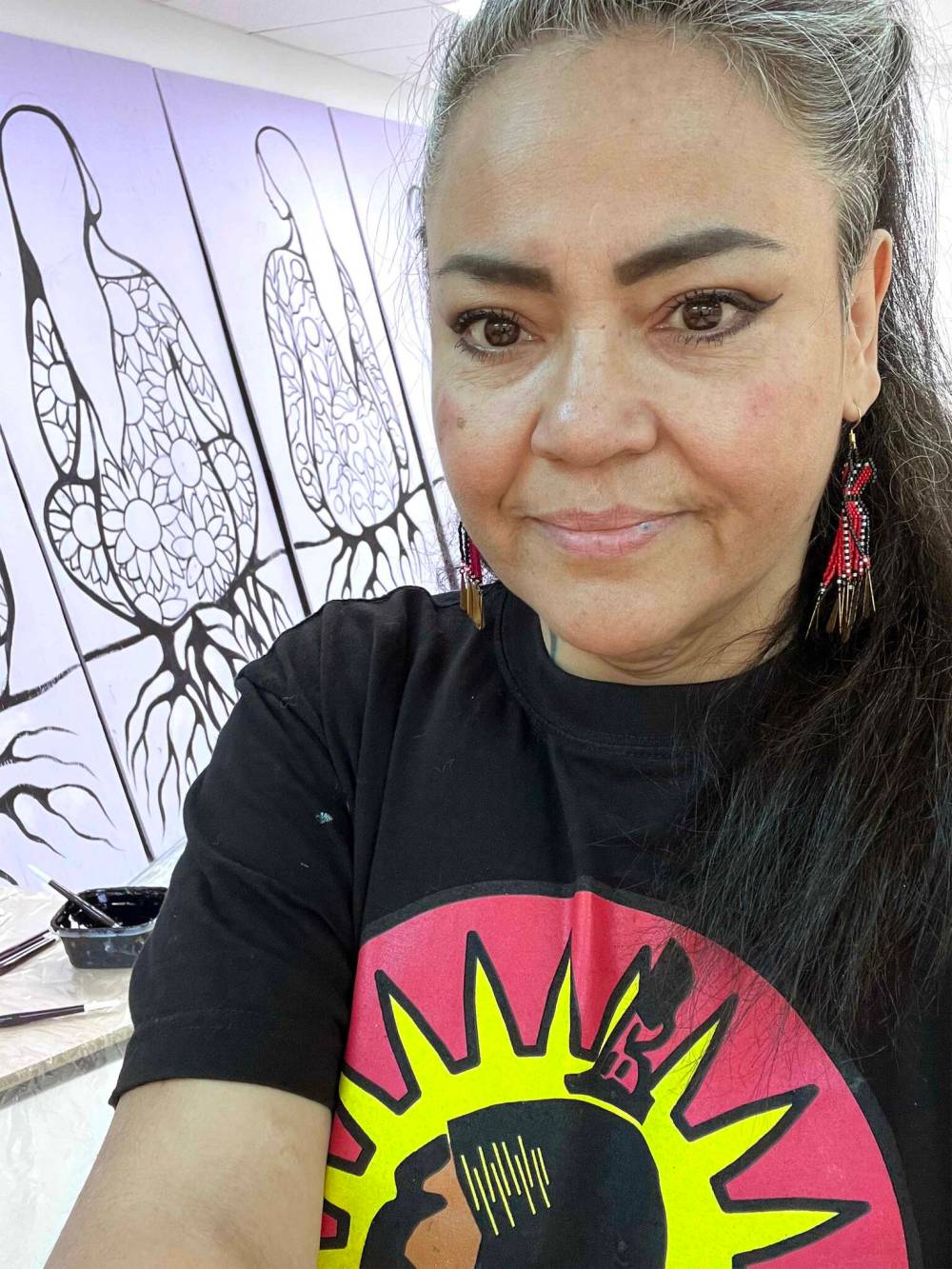
Ojibwa artist Jackie Traverse will honour Indigenous women that the community in The Pas lost.
With the help of students at Mary Duncan School, the Ojibwa artist will be working on a mural in the Woodland style — vibrant colours, thick black outlines — to honour Indigenous women the community has lost, including 18-year-old Kendara Ballantyne, whose body was discovered two weeks after she was reported missing in 2019, and Helen Betty Osborne, who was murdered after being kidnapped, brutally beaten and sexually assaulted in 1971.
The mural will feature four panels, with four women seated, roots growing from them into the ground. Four is a sacred number, Traverse explains, and the women come from the earth, connected to the land, just as the women who inspired the piece were.
“Being a mother of three daughters and a granddaughter, I find it very important, and I love doing this type of work,” she says. “I wish I didn’t have to, but I love to honour our women, so that’s what I do.”
Traverse’s work can be seen in many places in Winnipeg, Manitoba and beyond. She’s behind the floral motifs that now adorn the University of Manitoba convocation regalia worn by the chancellor and president, billboards for companies and campaigns across Canada and her work has entered the private collections of politicians and been displayed in a lengthy list of art galleries.
In The Pas, where the pain arising from the scourge of missing and murdered Indigenous women and girls weighs heavily on the hearts of people in the community, she tries to use beauty in her art to fuel reflection.
“I want to make people think in a more subtle way about Indigenous women in this country and the connection we have to the land, the beauty of life itself, how important life is,” she says.
Traverse has collaborated with Winnipeg-based clothing brand Mondetta Performance Gear on a line featuring her designs. Fittingly, it will be available starting Monday. Proceeds from apparel purchases will go to Ikwe Widdjiitiwin, a women’s shelter in the city.
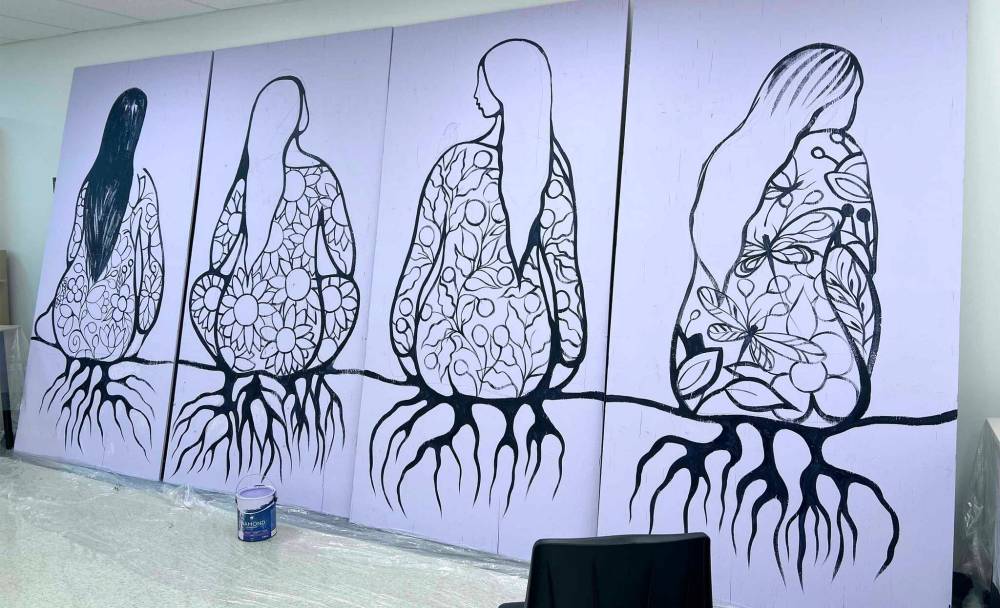
SUPPLIED
Jackie Traverse, with the help of students at Mary Duncan School, will be working on a mural. The mural features four panels, with four women seated, roots growing from them into the ground.
A ’60s Scoop survivor who found support from Ikwe Widdjiitiwin earlier in life, Traverse says everything is connected — when we mark the National Day for Truth and Reconciliation, we recognize people impacted today by colonization, too.
“I’m not really like paying attention to stat holidays and stuff like that, because that’s not what it’s about for me,” she says.
“It’s just a day to honour and remember the children, the women, the things that have happened to the children and the women of this country. Those are the things I’m reminded of on Sept. 30.”
Breanna Rayne Mink has generational ties to the youth centre she works at.
Mink, 16, started visiting the downtown drop-in centre with her parents when she was just six, and her grandmother is an employee. Now, she’s not just a junior staff member, working with kids who come by for meals, activities and Indigenous cultural programming, she’s also an artist whose designs are being featured on Rossbrook House’s orange shirts. Proceeds from sales of the $25 shirts — available on the non-profit’s website — go to support its operations.
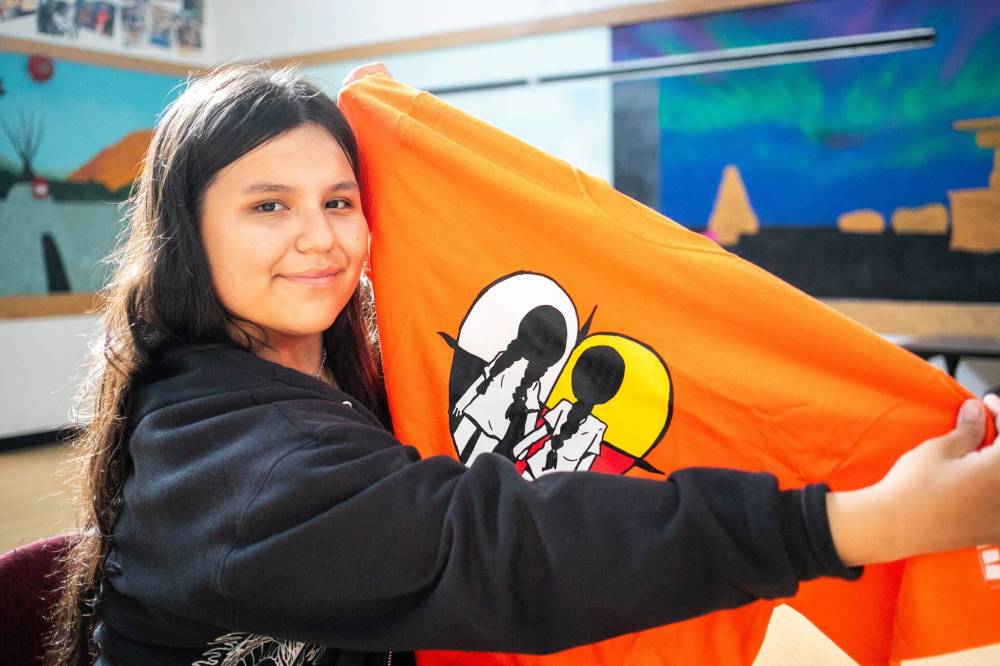
Breanna Rayne Mink, 16, designed orange shirt day T-shirts that Rossbrook House sells to raise funds at an inner-city drop-in centre.
Mink, who is Swampy Cree, is shy and soft-spoken, but describes her design — two girls with braided hair, holding hands in front of a medicine wheel — as indicative of what Rossbrook House did for her and her relatives.
“I wanted to show what Rossbrook represents. They look like two kids in the drawing, because that’s what it is like,” she says. “Kids come here, and they make friends. The whole saying here is, ‘No child should be alone if they ever have to be.’ And I wanted to really show that.”
Rossbrook House executive director Patty Mainville said Mink’s design is a symbol of reconciliation — love triumphing over trauma.
“A huge part of our population here at Rossbrook House are Indigenous, and it’s very generational … broken down by the residential school system within our families,” she says.
“We are residential school survivors — sons, daughters, grandchildren, great grandchildren.”
Mink continues to draw, paint and design jewelry. She plans to spend Monday with her parents and grandmother, and with her Rossbrook House family, too.
Raven Morrisseau will be visiting Nunavut.
The law student is part of a delegation of alumni from the University of Manitoba’s Indigenous Circle of Empowerment program attending the SevenGen Summit in Iqaluit from Tuesday to Thursday next week. The youth gathering brings together Indigenous people from across the country to discuss the future of sustainable energy.
They plan to be in Iqaluit a day early, in time for the National Day of Truth and Reconciliation, to spend the day with others reflecting and hearing the stories of Inuit survivors.
“In Winnipeg, we definitely have a growing Inuit population, but it’s not to the extent of other areas,” she says. “I think a lot of us are really happy that we can actually meet with people who are part of the community and understand their stories and the impact of this day that’s from a different perspective than we have here in Winnipeg.”
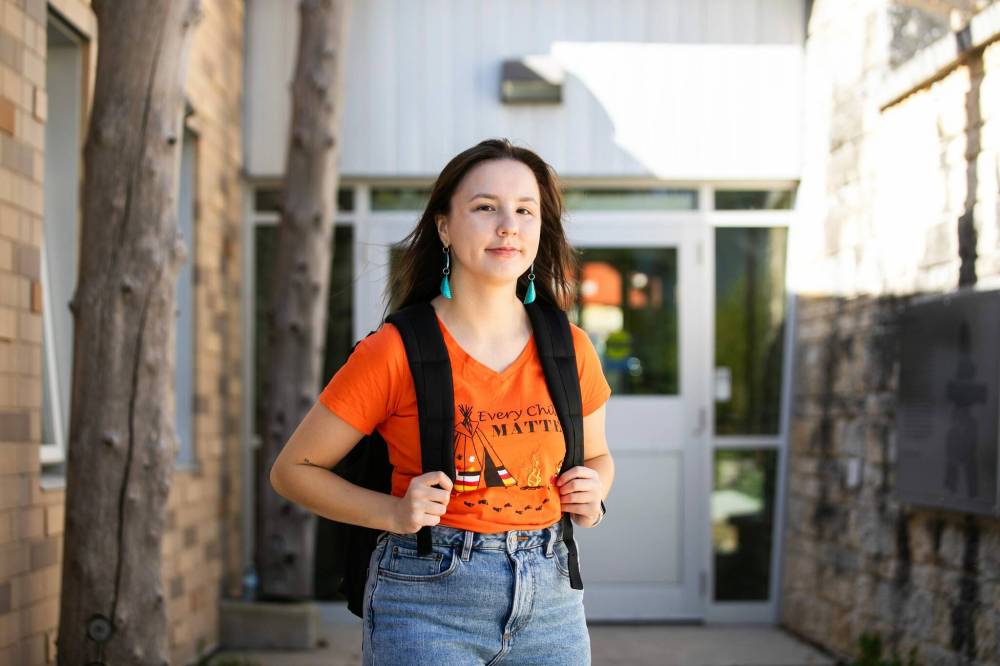
Raven Morrisseau will travel to Nunavut to attend the SevenGen Summit in Iqaluit.
Different as they may be, there are connective threads among the students heading to Iqaluit and the people they’ll meet there. One that particularly interests Morrisseau is the preservation of language: her great-grandmother attended a residential school, both her grandparents went to day schools and the Cree her grandmother spoke wasn’t passed down to her mother, or to her.
She’s taking classes in hopes of regaining her family language. In Nunavut, young people have worked to keep Inuktut — an umbrella term for Inuit languages — alive.
“I find when you know you both have this generational thing that has happened in your family, if you meet with someone, even though it’s a difficult part of your family’s history and story, it’s also a really good kind of building point to connect with each other and a kind of shared experience,” she says.
To Morrisseau, sharing knowledge is healing. That’s how she hopes to spend Monday.
“Education, to me, is one of the biggest parts of this day, because so much of our history and our learning for many years was half there. Even the tiniest bits, and so much of it, was removed or lied about,” she says.
“I think no matter what age or person you are, I think you have time to go and relearn things, because you’re going to actually get the truth of it.”
Christine Brouzes rolls out black, white and orange polymer clay, stacking it into a thick cylinder. It’s hard to tell immediately, but after hours of squishing, rolling and slicing, the clay will soon be transformed into dozens of pins with simple, yet meaningful imagery — a black-outlined orange shirt, with a small, glow-in-the dark halo above it, to represent children who never made it home from residential schools.
The Métis artist has made hundreds of the pins, and they’ve made their way to local businesses, schools and museums. She donates the proceeds to various charities.

Métis artist Christine Brouzes makes clay pins by hand to mark Orange Shirt Day.
“I order the clay from London, England, of all places, because I bought out almost all the clay in North America that is red or orange-coloured,” she says with a laugh.
She’s made pins to mark other causes close to her heart, featuring handmade clay red dresses, medicine wheels and pride insignia.
“I really focus on producing images that are important to people … it doesn’t mean just because you’re wearing a pin that you’re an expert on that subject,” she says. “It means you support it, you’re thinking of it and you’re wanting to keep the conversation going.”
You can find the orange shirt pins for sale at the Exchange District’s Amsterdam Tea Room, which will be closing its doors on Sept. 30 for the third consecutive year.
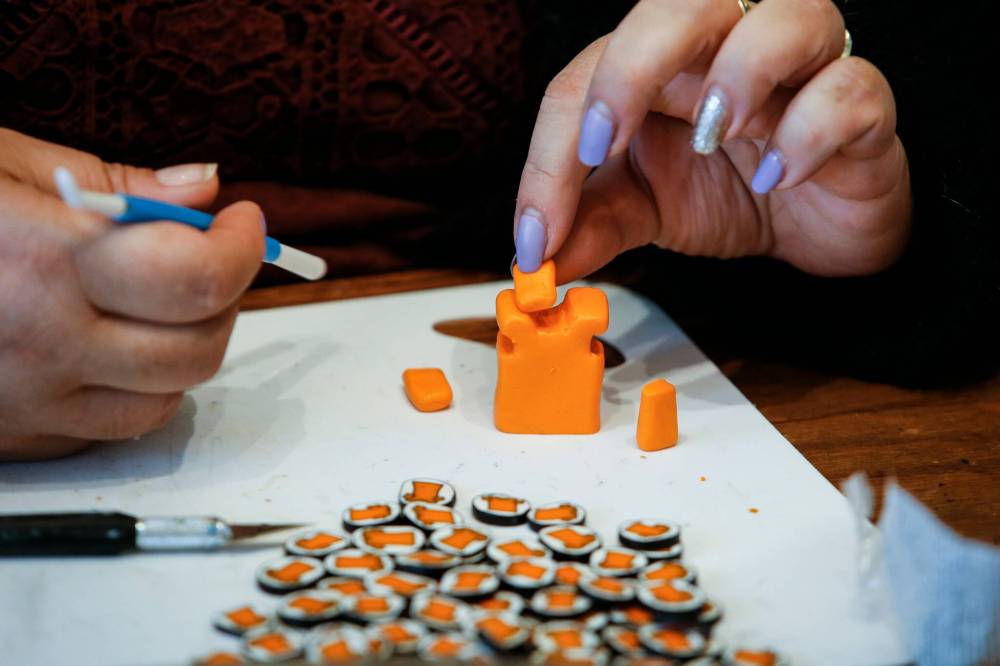
Brouzes has made hundreds of the pins and donates the proceeds to various charities.
Mark Turner, who owns the bar and restaurant, describes himself as originally being “completely ignorant” of Canada’s history when he first moved to Winnipeg from Scotland. Educated by friends and community members, he closed the doors for the first time on Sept. 30 in 2022 to recognize the impact residential schools had on so many people.
When he and his staff looked for a way to do more, he reached out to Brouzes through social media about stocking her pins free of charge, and their partnership began.
Amsterdam Tea Room staff wear the pins, too, opening the door for conversation with customers and creating a chance for the education that opened Turner’s eyes.
“With this story in particular, Christine’s like the truth, and I’m the reconciliation,” he says.
“It should be very important to everybody,” he said. “We shouldn’t shy away from the things that make us feel bad … I don’t think you should feel guilt, but you should feel the responsibility to know the past and the history.”
Brouzes agrees.
“I am so excited and so glad that the government has decided to make this National Truth and Reconciliation day a day to be honoured,” she says.
“But I want everybody to consider it’s not just one day that we can make things right on. It is a journey. It is a path and anybody can participate in it.”
malak.abas@freepress.mb.ca

Malak Abas
Reporter
Malak Abas is a city reporter at the Free Press. Born and raised in Winnipeg’s North End, she led the campus paper at the University of Manitoba before joining the Free Press in 2020. Read more about Malak.
Every piece of reporting Malak produces is reviewed by an editing team before it is posted online or published in print — part of the Free Press‘s tradition, since 1872, of producing reliable independent journalism. Read more about Free Press’s history and mandate, and learn how our newsroom operates.
Our newsroom depends on a growing audience of readers to power our journalism. If you are not a paid reader, please consider becoming a subscriber.
Our newsroom depends on its audience of readers to power our journalism. Thank you for your support.